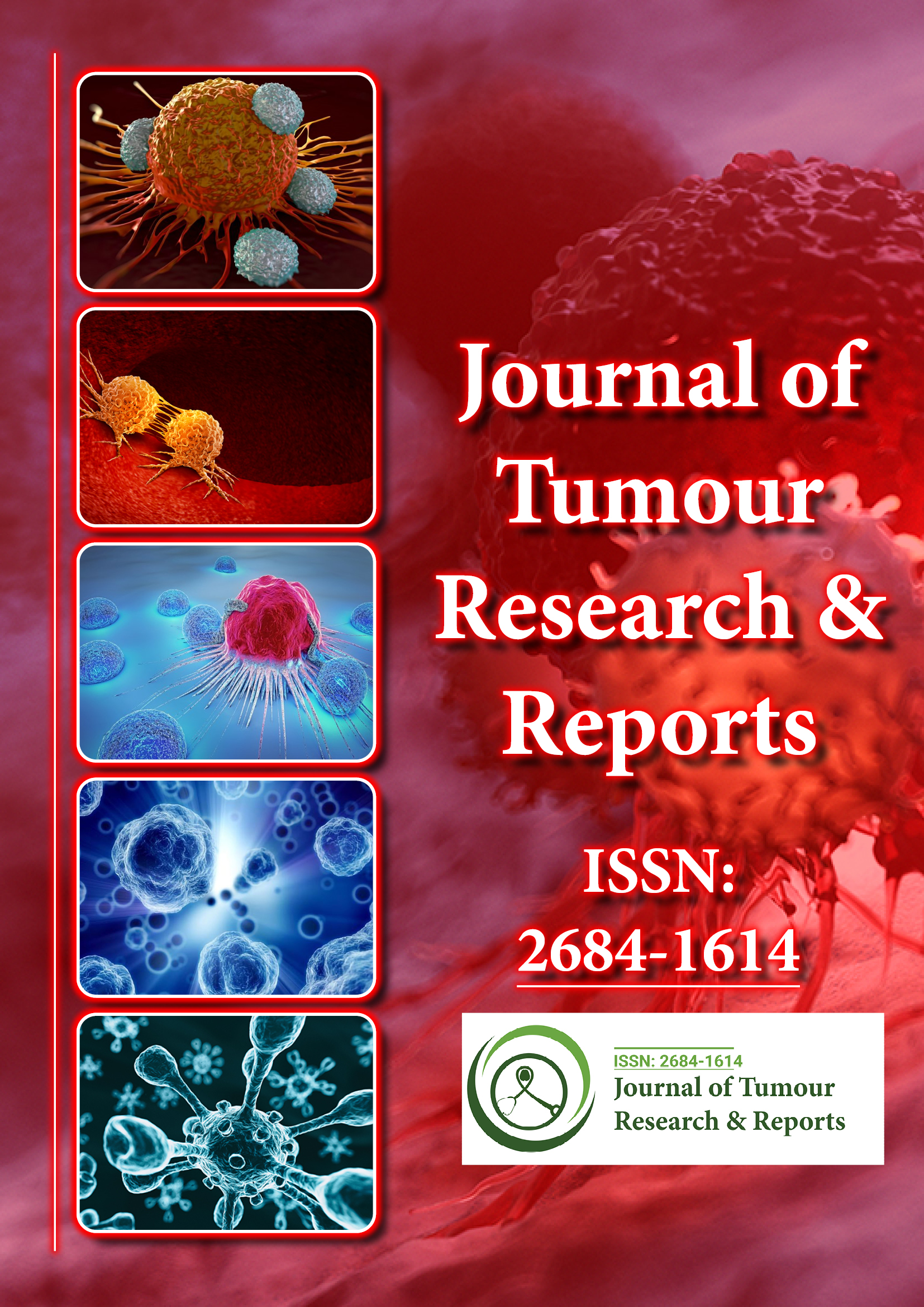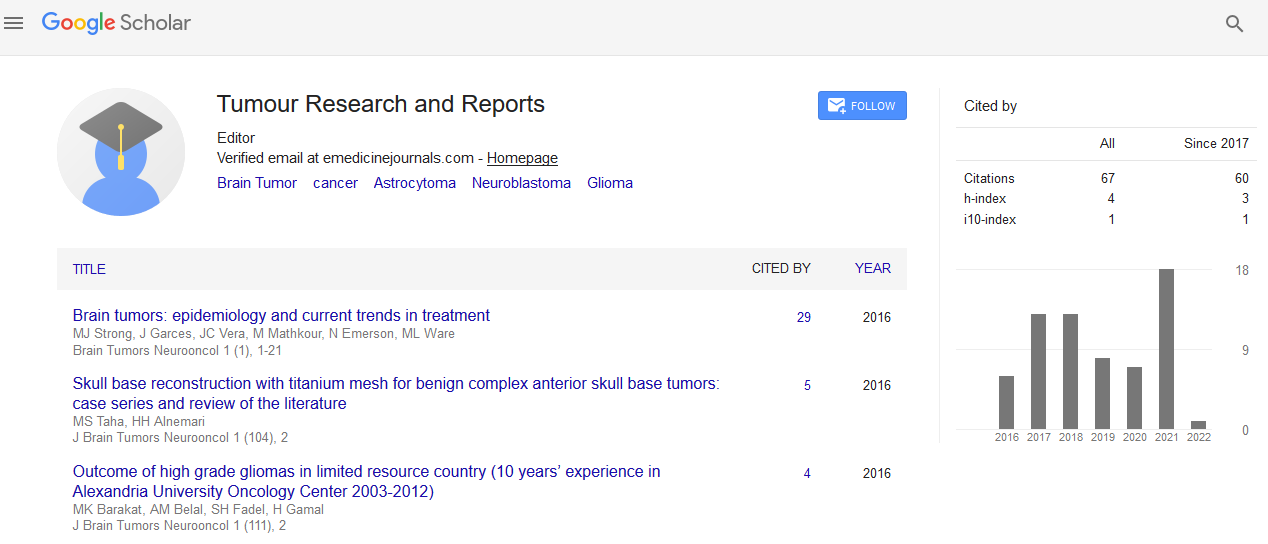Indexed In
- RefSeek
- Hamdard University
- EBSCO A-Z
- Google Scholar
Useful Links
Share This Page
Journal Flyer

Open Access Journals
- Agri and Aquaculture
- Biochemistry
- Bioinformatics & Systems Biology
- Business & Management
- Chemistry
- Clinical Sciences
- Engineering
- Food & Nutrition
- General Science
- Genetics & Molecular Biology
- Immunology & Microbiology
- Medical Sciences
- Neuroscience & Psychology
- Nursing & Health Care
- Pharmaceutical Sciences
Opinion Article - (2025) Volume 10, Issue 2
Metastasis: The Final Frontier of Tumour Progression
Jonathan Smith*Received: 30-May-2025, Manuscript No. JTRR-25-29822; Editor assigned: 02-Jun-2025, Pre QC No. JTRR-25-29822 (PQ); Reviewed: 16-Jun-2025, QC No. JTRR-25-29822; Revised: 23-Jun-2025, Manuscript No. JTRR-25-29822 (R); Published: 30-Jun-2025, DOI: 10.35248/2684-1614.25.10.261
Description
Metastasis represents the most lethal aspect of cancer, responsible for nearly 90% of cancer-related deaths worldwide. While primary tumours can often be surgically removed or controlled with localized therapies such as radiation or targeted treatment, the spread of cancer to distant organs remains the greatest barrier to cure. Unlike localized growth, metastasis transforms cancer into a systemic and life-threatening disease. Understanding how cancer cells acquire the ability to leave their site of origin, survive the hostile environment of circulation, and colonize distant tissues is central to improving patient outcomes. Despite decades of intensive research, metastasis continues to challenge oncologists and scientists alike, owing to its remarkable complexity and adaptability.
The process of metastasis, often referred to as the metastatic cascade, is not a single event but rather a series of interdependent and tightly regulated steps. Cancer cells must first undergo Epithelial-to-Mesenchymal Transition (EMT), a biological program that allows them to lose their epithelial characteristics, such as cell-cell adhesion, and gain mesenchymal traits that promote motility and invasiveness. Through EMT, tumour cells acquire the ability to migrate, degrade surrounding Extracellular Matrix (ECM), and infiltrate adjacent blood or lymphatic vessels in a process called intravasation.
Once tumour cells enter the circulation, they face an exceptionally hostile environment. In the bloodstream, they encounter shear stress from blood flow, surveillance and attack from immune cells such as Natural Killer (NK) cells, and a unique form of programmed cell death known as anoikis, which occurs when cells detach from their native matrix. Only a small fraction of Circulating Tumour Cells (CTCs) manage to survive these challenges. Interestingly, cancer cells often travel as clusters or bind to platelets, shielding themselves from immune attack and increasing their metastatic potential.
Surviving cells then undergo extravasation, the process of leaving blood vessels and invading new tissues. However, entry into a distant organ is only the beginning. To successfully colonize, cancer cells must adapt to an unfamiliar microenvironment that may initially be hostile to their growth. This adaptation is facilitated by the creation of a pre-metastatic niche, a supportive microenvironment prepared in advance by tumour-secreted factors, exosomes, and bone marrow derived cells. These factors alter the distant tissue, making it more receptive to arriving cancer cells. The ability of tumours to manipulate distant organs before colonization underscores the systemic nature of cancer and highlights why metastasis is so difficult to combat.
A striking feature of metastasis is its organ specificity. Not all cancer cells can colonize every tissue; instead, they exhibit preferences for certain organs, a phenomenon long recognized in clinical practice. The classic “seed and soil” hypothesis, proposed by Stephen Paget in 1889, suggests that cancer cells (the “seeds”) can only grow in favourable microenvironments (the “soil”). For instance, breast cancer frequently metastasizes to bone, liver, and lung, while prostate cancer also shows a strong preference for bone. Similarly, colorectal cancer often spreads to the liver, largely due to its anatomical connection through the portal circulation. Beyond anatomy, molecular interactions play a crucial role. Chemokine receptors such as CXCR4 on tumour cells, and their ligands in specific target organs, guide tumour cells to particular metastatic sites. Understanding these organotropic signals offers an opportunity to predict patterns of spread and potentially intervene before metastasis occurs.
Despite the advances in knowledge, therapeutically targeting metastasis remains an enormous challenge. Most current cancer therapies are designed to shrink or control primary tumours, rather than prevent their dissemination. Promising antimetastatic strategies include blocking EMT to prevent cancer cell migration, inhibiting Matrix Metalloproteinases (MMPs) to reduce ECM degradation, and disrupting the formation of premetastatic niches. Immunotherapy also offers new hope: Strategies that enhance immune surveillance, such as checkpoint inhibitors or NK cell-based therapies, may improve clearance of circulating tumour cells. Still, by the time metastasis becomes clinically detectable, the disease is often widespread and resistant to conventional therapies.
A major area of current research is early detection of metastasis. Techniques such as circulating tumour DNA (ctDNA) analysis, liquid biopsy, and CTC enumeration are being developed to identify metastatic spread at the earliest possible stage. These approaches hold the promise of intervening before metastases are fully established. Advances in imaging technologies, combined with molecular diagnostics, could one day allow clinicians to track metastatic progression in real time, transforming how treatment decisions are made.
Citation: Smith J (2025). Metastasis: The Final Frontier of Tumour Progression. J Tum Res Reports. 10:261.
Copyright: © 2025 Smith J. This is an open-access article distributed under the terms of the Creative Commons Attribution License, which permits unrestricted use, distribution, and reproduction in any medium, provided the original author and source are credited.

